The Pressure-Volume Loop Systems Market is estimated to be valued at USD 1.3 billion in 2025 and is projected to reach USD 3.2 billion by 2035, registering a compound annual growth rate (CAGR) of 9.2% over the forecast period.
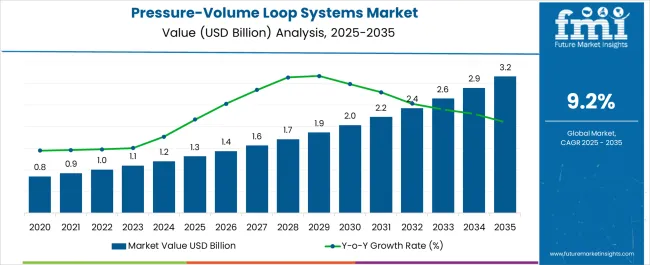
| Metric | Value |
|---|---|
| Pressure-Volume Loop Systems Market Estimated Value in (2025 E) | USD 1.3 billion |
| Pressure-Volume Loop Systems Market Forecast Value in (2035 F) | USD 3.2 billion |
| Forecast CAGR (2025 to 2035) | 9.2% |
The Pressure-Volume Loop Systems market is experiencing strong growth, driven by the increasing adoption of advanced cardiac monitoring solutions in research and clinical settings. Rising prevalence of cardiovascular diseases and the need for precise assessment of cardiac function are supporting market expansion. These systems provide detailed insights into ventricular performance, contractility, and overall hemodynamics, enabling improved preclinical and translational research outcomes.
Technological advancements, including high-resolution sensors, real-time data acquisition, and integration with analytical software, have enhanced the reliability and accuracy of these systems. The growing focus on drug development, cardiovascular research, and personalized medicine has further accelerated demand.
Integration of Pressure-Volume Loop Systems with automated data analysis platforms and compatibility with various animal models enhances their utility for research organizations As pharmaceutical companies, academic institutions, and research facilities continue to prioritize efficiency, reproducibility, and precise functional assessment, the market is expected to sustain long-term growth, driven by increasing investments in cardiac research, cardiovascular therapeutics, and preclinical studies across global markets.
The pressure-volume loop systems market is segmented by parameter, application, end user, and geographic regions. By parameter, pressure-volume loop systems market is divided into Contractility Index (ESPVR), Elastance (EDPVR), Cardiac Output, Stroke Volume, Max And Min Ventricular Dp/Dt, Pre-Load Recruitable Stroke Work (PRSW), Ejection Fraction, and Others. In terms of application, pressure-volume loop systems market is classified into Baseline PV Loop Analysis, Occlusion PV Loop Analysis, Phenotyping Gene Manipulations, Cardiac Hypertrophy, Cardiac Failure, Cardiovascular Remodeling, Toxicology, Pharmacology (Rapid Drug Screening), Cardiac Resynchronization Therapy, and Others. Based on end user, pressure-volume loop systems market is segmented into Contract Research Organization, Biotech And Pharm Research, and Others. Regionally, the pressure-volume loop systems industry is classified into North America, Latin America, Western Europe, Eastern Europe, Balkan & Baltic Countries, Russia & Belarus, Central Asia, East Asia, South Asia & Pacific, and the Middle East & Africa.
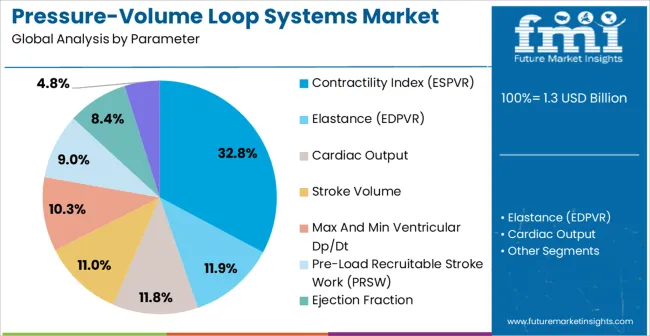
The contractility index (ESPVR) parameter segment is projected to hold 32.8% of the market revenue in 2025, making it the leading parameter type. Its dominance is being driven by the ability to provide an accurate and load-independent measure of ventricular contractility, which is critical for assessing cardiac function in preclinical and translational studies. These parameters enable researchers to evaluate drug efficacy, disease progression, and cardiac performance with high precision.
The adoption of automated data acquisition and advanced analytics tools has enhanced usability and reproducibility, increasing preference among research institutions. The capability to integrate ESPVR assessment with other hemodynamic measurements provides comprehensive insights into cardiac physiology.
Ongoing advancements in sensor technology, software platforms, and animal modeling have further reinforced the reliability of ESPVR measurements As demand for accurate, reproducible, and clinically relevant cardiac function assessments grows, the contractility index segment is expected to maintain its leading market position, supported by continued innovation and widespread adoption in cardiovascular research.
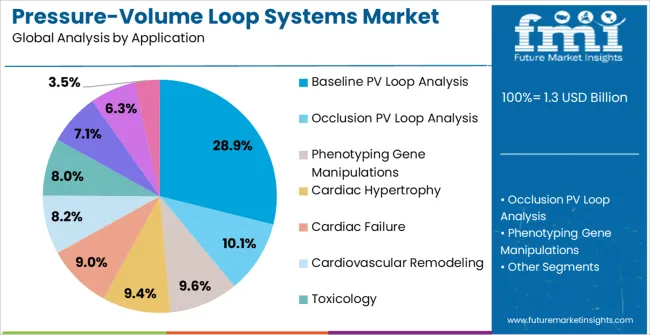
The baseline PV loop analysis segment is anticipated to account for 28.9% of the market revenue in 2025, establishing it as the leading application area. Growth is being driven by the need to perform fundamental assessments of cardiac performance and ventricular mechanics in preclinical studies. Baseline PV loop analysis provides essential data on ventricular pressure-volume relationships, enabling precise evaluation of cardiac function under various physiological and experimental conditions.
The adoption of high-precision measurement systems and automated analysis software has enhanced the accuracy, reliability, and ease of conducting PV loop studies. Research organizations and pharmaceutical companies increasingly rely on these analyses for evaluating the effects of new therapies, disease modeling, and cardiac performance benchmarking.
Integration with real-time monitoring and data acquisition platforms further enhances usability As cardiovascular research and drug development continue to expand globally, the baseline PV loop analysis segment is expected to remain a critical application, supporting reproducible and actionable insights while reinforcing the adoption of pressure-volume loop systems across research institutions.
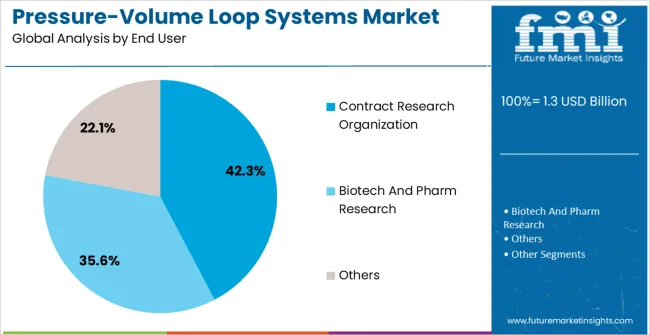
The contract research organization end user segment is projected to hold 42.3% of the market revenue in 2025, making it the leading end-user category. Growth in this segment is being driven by the increasing outsourcing of preclinical and translational cardiovascular research to specialized organizations that offer expertise, infrastructure, and operational efficiency. CROs utilize pressure-volume loop systems to perform standardized, high-throughput, and reproducible cardiac function assessments for pharmaceutical and biotechnology clients.
The ability to provide comprehensive data, maintain compliance with regulatory requirements, and accelerate drug development timelines has reinforced adoption among global CROs. Integration of advanced analytics, automation, and multi-parameter assessment capabilities enhances research quality and reduces experimental variability.
Rising investments in contract research and the increasing complexity of cardiovascular studies are further supporting the segment’s market share As pharmaceutical companies continue to leverage CRO services for cost-effective and reliable cardiac research, the contract research organization segment is expected to remain the primary driver of market growth, ensuring widespread deployment of pressure-volume loop systems.
The flow of blood in the body should be properly to maintain the balance for better health. The flow of the blood should be proper, especially when the blood flow from heart to the different part of the body. The flow of blood in the vein and artery, should be in proper pattern with proper pressure.
The pressure-volume loop systems is help full for studying the heart blood flow from in to out, this study help to protect the heart related problem in the body and also to understand the concentrate myocardial contractility, consistence, muscle energetics and other quantitative measures of heart work.
The study also indicate the major and minor problem with respect to heart related problem. The flow of blood in proper PV (pressure volume pattern). The main work of pressure-volume loop systems is to measure the ventricular pressure and also the volume from the whole beating of heart of the body. The pressure-volume loop systems is use for many research to understand the flow and the pattern especially in transgenic mice and also in livestock.
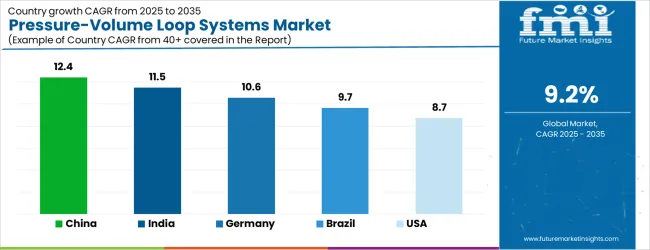
| Country | CAGR |
|---|---|
| China | 12.4% |
| India | 11.5% |
| Germany | 10.6% |
| Brazil | 9.7% |
| USA | 8.7% |
| UK | 7.8% |
| Japan | 6.9% |
The Pressure-Volume Loop Systems Market is expected to register a CAGR of 9.2% during the forecast period, exhibiting varied country level momentum. China leads with the highest CAGR of 12.4%, followed by India at 11.5%. Developed markets such as Germany, France, and the UK continue to expand steadily, while the USA is likely to grow at consistent rates. Japan posts the lowest CAGR at 6.9%, yet still underscores a broadly positive trajectory for the global Pressure-Volume Loop Systems Market. In 2024, Germany held a dominant revenue in the Western Europe market and is expected to grow with a CAGR of 10.6%. The USA Pressure-Volume Loop Systems Market is estimated to be valued at USD 464.5 million in 2025 and is anticipated to reach a valuation of USD 464.5 million by 2035. Sales are projected to rise at a CAGR of 0.0% over the forecast period between 2025 and 2035. While Japan and South Korea markets are estimated to be valued at USD 67.9 million and USD 37.4 million respectively in 2025.
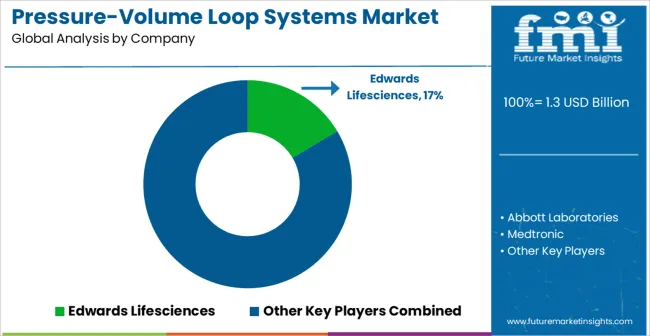
| Item | Value |
|---|---|
| Quantitative Units | USD 1.3 Billion |
| Parameter | Contractility Index (ESPVR), Elastance (EDPVR), Cardiac Output, Stroke Volume, Max And Min Ventricular Dp/Dt, Pre-Load Recruitable Stroke Work (PRSW), Ejection Fraction, and Others |
| Application | Baseline PV Loop Analysis, Occlusion PV Loop Analysis, Phenotyping Gene Manipulations, Cardiac Hypertrophy, Cardiac Failure, Cardiovascular Remodeling, Toxicology, Pharmacology (Rapid Drug Screening), Cardiac Resynchronization Therapy, and Others |
| End User | Contract Research Organization, Biotech And Pharm Research, and Others |
| Regions Covered | North America, Europe, Asia-Pacific, Latin America, Middle East & Africa |
| Country Covered | United States, Canada, Germany, France, United Kingdom, China, Japan, India, Brazil, South Africa |
| Key Companies Profiled | Edwards Lifesciences, Abbott Laboratories, Medtronic, GE Healthcare, Philips Healthcare, LiDCO, PiCCO, PulseCath, DiaSorin, Baxter International, and Terumo Corporation |
The global pressure-volume loop systems market is estimated to be valued at USD 1.3 billion in 2025.
The market size for the pressure-volume loop systems market is projected to reach USD 3.2 billion by 2035.
The pressure-volume loop systems market is expected to grow at a 9.2% CAGR between 2025 and 2035.
The key product types in pressure-volume loop systems market are contractility index (espvr), elastance (edpvr), cardiac output, stroke volume, max and min ventricular dp/dt, pre-load recruitable stroke work (prsw), ejection fraction and others.
In terms of application, baseline pv loop analysis segment to command 28.9% share in the pressure-volume loop systems market in 2025.






Our Research Products

The "Full Research Suite" delivers actionable market intel, deep dives on markets or technologies, so clients act faster, cut risk, and unlock growth.

The Leaderboard benchmarks and ranks top vendors, classifying them as Established Leaders, Leading Challengers, or Disruptors & Challengers.

Locates where complements amplify value and substitutes erode it, forecasting net impact by horizon

We deliver granular, decision-grade intel: market sizing, 5-year forecasts, pricing, adoption, usage, revenue, and operational KPIs—plus competitor tracking, regulation, and value chains—across 60 countries broadly.

Spot the shifts before they hit your P&L. We track inflection points, adoption curves, pricing moves, and ecosystem plays to show where demand is heading, why it is changing, and what to do next across high-growth markets and disruptive tech

Real-time reads of user behavior. We track shifting priorities, perceptions of today’s and next-gen services, and provider experience, then pace how fast tech moves from trial to adoption, blending buyer, consumer, and channel inputs with social signals (#WhySwitch, #UX).

Partner with our analyst team to build a custom report designed around your business priorities. From analysing market trends to assessing competitors or crafting bespoke datasets, we tailor insights to your needs.
Supplier Intelligence
Discovery & Profiling
Capacity & Footprint
Performance & Risk
Compliance & Governance
Commercial Readiness
Who Supplies Whom
Scorecards & Shortlists
Playbooks & Docs
Category Intelligence
Definition & Scope
Demand & Use Cases
Cost Drivers
Market Structure
Supply Chain Map
Trade & Policy
Operating Norms
Deliverables
Buyer Intelligence
Account Basics
Spend & Scope
Procurement Model
Vendor Requirements
Terms & Policies
Entry Strategy
Pain Points & Triggers
Outputs
Pricing Analysis
Benchmarks
Trends
Should-Cost
Indexation
Landed Cost
Commercial Terms
Deliverables
Brand Analysis
Positioning & Value Prop
Share & Presence
Customer Evidence
Go-to-Market
Digital & Reputation
Compliance & Trust
KPIs & Gaps
Outputs
Full Research Suite comprises of:
Market outlook & trends analysis
Interviews & case studies
Strategic recommendations
Vendor profiles & capabilities analysis
5-year forecasts
8 regions and 60+ country-level data splits
Market segment data splits
12 months of continuous data updates
DELIVERED AS:
PDF EXCEL ONLINE
Loop-Mediated Isothermal Amplification Market Analysis - Size, Share, and Forecast Outlook 2025 to 2035
Loop Handle Bags Market Insights and Forecast 2025 to 2035
2 Loop FIBC Bags Market Size and Share Forecast Outlook 2025 to 2035
4-Loop FIBC Market Growth - Size, Demand & Forecast 2025 to 2035
Breaking Down Market Share in 2 Loop FIBC Bags
Competitive Landscape of 4-Loop FIBC Providers
Hyperloop Train Market Growth - Trends & Forecast 205 to 2035
Hyperloop Technology Market
Single Loop Controller Market Size, Growth, and Forecast 2025 to 2035
Asia Pacific Loop-mediated Isothermal Amplification (LAMP) Market Size and Share Forecast Outlook 2025 to 2035
Automotive Closed Loop Current Transducer Market Size and Share Forecast Outlook 2025 to 2035
Utility Scale Open Loop Current Transducer Market Size and Share Forecast Outlook 2025 to 2035
Orthopedic Titanium Plate with Loop Market Size and Share Forecast Outlook 2025 to 2035
Systems Administration Management Tools Market Size and Share Forecast Outlook 2025 to 2035
VRF Systems Market Growth - Trends & Forecast 2025 to 2035
Cloud Systems Management Software Market Size and Share Forecast Outlook 2025 to 2035
Hi-Fi Systems Market Size and Share Forecast Outlook 2025 to 2035
Cough systems Market
Backpack Systems Market Size and Share Forecast Outlook 2025 to 2035
Unmanned Systems Market Analysis - Size, Share, & Forecast Outlook 2025 to 2035

Thank you!
You will receive an email from our Business Development Manager. Please be sure to check your SPAM/JUNK folder too.
Chat With
MaRIA